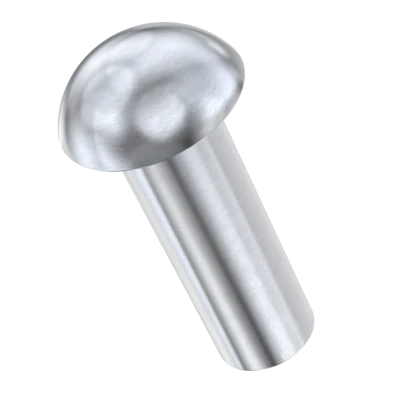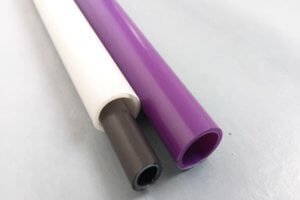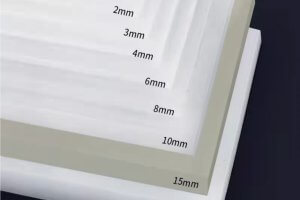Introduction: The Critical Role of Rivets in Multiple Industries
Rivets are permanent mechanical fasteners that are critical in the assembly of everything from simple structures to complex machinery across numerous industries. Their primary purpose is to join two or more pieces of material—typically metal, plastic, or composite—in a way that can withstand shearing and tensile loads. A rivet basically consists of a cylindrical shaft with a head on one end; once installed, the tail end is deformed so it expands, creating a second head and clamping the materials securely together. This process ensures an exceptionally strong joint crucial for the integrity and safety of everything from automobiles and airplanes to bridges and buildings. By employing this age-old yet ever-evolving technology, riveting remains fundamental in manufacturing and construction due to its reliability and simplicity.
Solid Rivets: Description and Structure
Solid rivets are among the oldest and most reliable types of fasteners, characterized by their cylindrical shafts with a head on one end and a flat or rounded tail on the other. They are usually made from malleable metals such as steel, aluminum, or copper, which allows them to be deformed with a hammer or a rivet gun to hold two pieces of material firmly together. The installation process involves passing the body of the rivet through pre-drilled holes in the objects to be joined and then deforming the tail side, creating a second head that ensures the joint is secure. Thanks to this straightforward but sturdy design, solid rivets find common applications in industries where structural integrity is critical, including aircraft manufacturing, bridge construction, and heavy machinery assembly, acting as permanent mechanical fasteners ensuring safety and resilience.
Blind Rivets: Design, Installation, and Applications
Design Characteristics: Blind rivets, commonly referred to as pop rivets, are tubular fasteners with a mandrel through the center. They’re designed for joining materials from one side where the opposite side is inaccessible or ‘blind’ to the operator. The rivet’s body is pre-assembled onto the mandrel, which has a predetermined breaking point near its rounded end.
Installation Process: During installation, a specialized tool pulls the mandrel through the body, causing it to expand and clamp onto the materials. For instance, when securing two metal sheets, the tool draws the mandrel into the rivet body, flaring the end until the pulling force surpasses the mandrel’s tensile strength, snapping it off at the break point, leaving behind a secure joint.
Uses Across Different Projects: Blind rivets excel in applications such as assembling electronic components within confined spaces, attaching signs or panels onto buildings, or constructing automotive parts where only one side of the workpiece is visible or reachable. Their reliability and ease of use make them indispensable in both industrial manufacturing and small-scale projects.
Semi-Tubular Rivets
Semi-tubular rivets have a design that features a hole at one end, extending partially through the shank, which creates a tubular section within an otherwise solid rivet. This design reduces the amount of force needed for installation compared to solid rivets, as it allows the semi-tubular part to deform and flare outwards when applied. To illustrate their functionality in practical terms, take the assembly of lightweight furniture or electronics: these rivets are ideal here, because they can be set with less impact, avoiding damage to delicate components while still providing strong, reliable joints. Unlike solid rivets that require considerable force and may risk distorting sensitive parts during peening, semi-tubular rivets simplify placement while minimizing potential harm to other hardware elements.
Drive Rivets: Structural Features and Application Method
Drive rivets are characterized by a short, tubular body with a flange at one end and a slightly dome-shaped or flat head at the other. To apply these rivets, one must insert the body through aligned holes in the materials to be joined, then drive the mandrel into the body using a hammer or a specialized tool; this causes the body to expand and tightly grip the surrounding material. For example, when securing a nameplate on an outdoor piece of equipment where access to the backside is not possible, drive rivets offer a fast and robust solution as they can be installed from one side without requiring extra support for the tail end.
Oscar Rivets
Unique in design, Oscar rivets are characterized by their high retention capabilities due to a mechanical locking feature. This type of rivet expands upon installation to provide superior holding power, making them well-suited for applications where the joint is subject to heavy vibration or stress. For instance, in the manufacturing of commercial trailers, the dynamic forces exerted during transit calls for fasteners that can maintain integrity over long durations; here, Oscar rivets are preferred. Their ability to resist pull-through and their tolerance to deformation under load also make them ideal for use in the construction of bridges or industrial machinery, where safety and reliability are paramount.
Flush Rivets and Their Aerodynamic Advantages
Flush rivets are integral to the aerospace industry due to their ability to provide a smooth surface, reducing aerodynamic drag on aircraft structures. By sitting level with the material surface, they enhance airflow over the airframe, contributing significantly to the efficiency of an aircraft’s performance in flight. One notable application is on the outer skin of modern commercial jets, where maintaining an uninterrupted, sleek exterior is essential for both fuel efficiency and noise reduction. The inherent design of flush rivets effectively eliminates any protrusions that might compromise the integrity of the surface finish, thereby playing a crucial role in the aerodynamics of high-speed aircraft.
Friction-Lock Rivets: Mechanism and Material Composition
Friction-lock rivets are a special category of fasteners that operate on the principle of frictional interlock. These rivets consist mainly of aluminum alloy, which allows for both strength and pliability in their application. Upon insertion into pre-drilled holes, they are deformed with a pulling force from an installation tool, creating a bulge at the blind side that holds the components together through friction and mechanical locking. Unlike conventional solid or pop rivets, friction-lock variants do not require access to both sides of the assembly, thus offering unique utility in locations where only one side is reachable.
Distinct Uses of Friction-Lock Rivets
Compared to other types of rivets, friction-lock rivets stand out due to their ease of installation along with exceptional hold strength. They are particularly valued in aerospace and automotive industries for securing panels and components where post-installation inspection may be challenging. The absence of a requirement for rear-side access simplifies their use in confined spaces. This method of fastening reduces the need for skilled labor and specialized equipment, leading to efficiency gains in manufacturing and repair processes where quick and reliable joining solutions are essential.
Self-Piercing Rivets
The technology behind self-piercing rivets (SPRs) allows for the joining of two or more sheets of material without the need for pre-prepared holes. The design and engineering of SPRs enable the rivet to pierce through the layers during the riveting process itself, which expedites assembly operations and provides robust joint quality. For example, in automotive manufacturing, using SPRs significantly improves production efficiency by reducing the number of steps required for panel attachment. Additionally, the resultant joints exhibit high resistance to vibrations and fatigue, crucial attributes for vehicle longevity and safety.
Considerations for Choosing the Right Rivet
When choosing a rivet for any project, it’s essential to consider several factors including material compatibility, joint strength requirements, and installation methods. The type of materials being joined often dictates the rivet material: aluminum rivets are frequently used with aluminum structures to prevent corrosion, while stainless steel or titanium rivets offer increased strength and durability for more demanding applications. Assessing the mechanical load that the joint will bear is crucial; shear and tensile strengths vary across rivet types, affecting overall joint integrity. Not all rivets can be installed using the same tools or methods—traditional solid rivets require bucking bars and hammers or pneumatic guns, whereas pop rivets utilize specialized hand or power riveters. Consequently, accessibility to both sides of the workpiece may influence your choice as some rivets, like blind rivets, only need access from one side. Ultimately, the correct balance between these considerations ensures a secure, long-lasting connection appropriate for the specific demands of the task at hand.
Other Articles You Might Enjoy
- Innovative CNC Machining for Custom Medical Instruments
Innovative CNC Machining for Custom Medical Instruments Computer Numeric Control (CNC) machining is an innovative automated process that utilizes computer software to control machine tools. The use of CNC machines…
- Aluminum Parts Machining: CNC Techniques for Precision and Efficiency
Introduction to Aluminum Parts Machining and CNC Techniques In the manufacturing industry, the machining of aluminum parts plays a crucial role for its effortless machinability which makes it an ideal…
- Tool Steel Grades in CNC Machining: Which One Should You Choose for Durability?
Introduction to Tool Steel in CNC Machining In the realm of CNC (Computer Numerical Control) machining, tool steel reigns supreme due to its exceptional durability and versatility. As a broad…










 Afrikaans
Afrikaans Albanian
Albanian Amharic
Amharic Arabic
Arabic Armenian
Armenian Azerbaijani
Azerbaijani Basque
Basque Belarusian
Belarusian Bengali
Bengali Bosnian
Bosnian Bulgarian
Bulgarian Catalan
Catalan Cebuano
Cebuano Chichewa
Chichewa Chinese (Simplified)
Chinese (Simplified) Chinese (Traditional)
Chinese (Traditional) Corsican
Corsican Croatian
Croatian Czech
Czech Danish
Danish Dutch
Dutch English
English Esperanto
Esperanto Estonian
Estonian Filipino
Filipino Finnish
Finnish French
French Frisian
Frisian Galician
Galician Georgian
Georgian German
German Greek
Greek Gujarati
Gujarati Haitian Creole
Haitian Creole Hausa
Hausa Hawaiian
Hawaiian Hebrew
Hebrew Hindi
Hindi Hmong
Hmong Hungarian
Hungarian Icelandic
Icelandic Igbo
Igbo Indonesian
Indonesian Irish
Irish Italian
Italian Japanese
Japanese Javanese
Javanese Kannada
Kannada Kazakh
Kazakh Khmer
Khmer Korean
Korean Kurdish (Kurmanji)
Kurdish (Kurmanji) Kyrgyz
Kyrgyz Lao
Lao Latin
Latin Latvian
Latvian Lithuanian
Lithuanian Luxembourgish
Luxembourgish Macedonian
Macedonian Malagasy
Malagasy Malay
Malay Malayalam
Malayalam Maltese
Maltese Maori
Maori Marathi
Marathi Mongolian
Mongolian Myanmar (Burmese)
Myanmar (Burmese) Nepali
Nepali Norwegian
Norwegian Pashto
Pashto Persian
Persian Polish
Polish Portuguese
Portuguese Punjabi
Punjabi Romanian
Romanian Russian
Russian Samoan
Samoan Scottish Gaelic
Scottish Gaelic Serbian
Serbian Sesotho
Sesotho Shona
Shona Sindhi
Sindhi Sinhala
Sinhala Slovak
Slovak Slovenian
Slovenian Somali
Somali Spanish
Spanish Sundanese
Sundanese Swahili
Swahili Swedish
Swedish Tajik
Tajik Tamil
Tamil Telugu
Telugu Thai
Thai Turkish
Turkish Ukrainian
Ukrainian Urdu
Urdu Uzbek
Uzbek Vietnamese
Vietnamese Welsh
Welsh Xhosa
Xhosa Yiddish
Yiddish Yoruba
Yoruba Zulu
Zulu